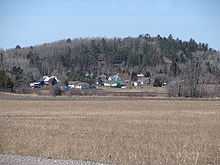Johnson, Ontario
| Johnson | |
|---|---|
| Township | |
 | |
 Johnson | |
| Coordinates: 46°20′N 83°56′W / 46.333°N 83.933°WCoordinates: 46°20′N 83°56′W / 46.333°N 83.933°W | |
| Country |
|
| Province |
|
| District | Algoma |
| Government | |
| • Type | Township |
| • Mayor |
Ted Hicks (2010-Present) Edith Orr (2006-2010) |
| • MP | Bryan Hayes (CPC) |
| • MPP | Michael Mantha (NDP) |
| Area[1] | |
| • Land | 120.38 km2 (46.48 sq mi) |
| Population (2011)[1] | |
| • Total | 750 |
| • Density | 6.2/km2 (16/sq mi) |
| Time zone | EST (UTC-5) |
| • Summer (DST) | EDT (UTC-4) |
| Postal code | P0R 1E0 |
| Area code(s) | 705 and 249 |
| Website | www.johnsontwp.ca |
Johnson is a township in the Canadian province of Ontario, located within the Algoma District. The township had a population of 750 in the Canada 2011 Census, up from 701 in the 2006 census.
Communities
Desbarats, the main community in the township, is located on Highway 17, 54 kilometres (34 mi) east of Sault Ste. Marie.
Located in Desbarats is Central Algoma Secondary School, a high school of 450+ students which serves a catchment area extending from Echo Bay to Thessalon.

West of Desbarats on Highway 17 is Ripple Rock, a unique rock cut that was uncovered with the blasting of the rock cuts through northern Ontario for the creation of the Trans-Canada Highway. The ripples in the rock were created two billion years ago by waves in a shallow body of water. It was buried and through pressure it became sandstone.
Puddingstone Road in Johnson Township was named for the geological phenomenon of puddingstone, found in the area as well as at nearby St. Joseph Island. Puddingstone is a mixture of different sized grains and pebbles held together by finer sand. The type found in this area is St. Joseph Island Puddingstone, which contains red and brown pieces of jasper.
Since the early 2000s, about 20 Mennonite families from Southern Ontario moved to the Desbarats area. Along with other local farmers, they sell their produce at the Desbarats Farmers' Market on Friday evenings and Saturday mornings.
Demographics
| |||||||||||||||||
Population trend:[5]
- Population in 2011: 750
- Population in 2006: 701
- Population in 2001: 658
- Population in 1996: 729
- Population in 1991: 685
See also
References
- ↑ 1.0 1.1 "Johnson census profile". 2011 Census of Population. Statistics Canada. Retrieved 2012-02-17.
- ↑ "2011 Community Profiles". Canada 2011 Census. Statistics Canada. July 5, 2013. Retrieved 2012-02-17.
- ↑ "2006 Community Profiles". Canada 2006 Census. Statistics Canada. March 30, 2011. Retrieved 2012-02-17.
- ↑ "2001 Community Profiles". Canada 2001 Census. Statistics Canada. February 17, 2012. Retrieved 2012-02-17.
- ↑ Statistics Canada: 1996, 2001, 2006 census
External links
| Wikimedia Commons has media related to Johnson, Ontario. |
 |
Laird | Macdonald, Meredith and Aberdeen Additional |  | |
| Tarbutt and Tarbutt Additional | |
Plummer Additional | ||
| ||||
| | ||||
| St. Joseph Channel / St. Joseph, Hilton (St. Joseph Island) |
| ||||||||||||||||||||||||||||||||
